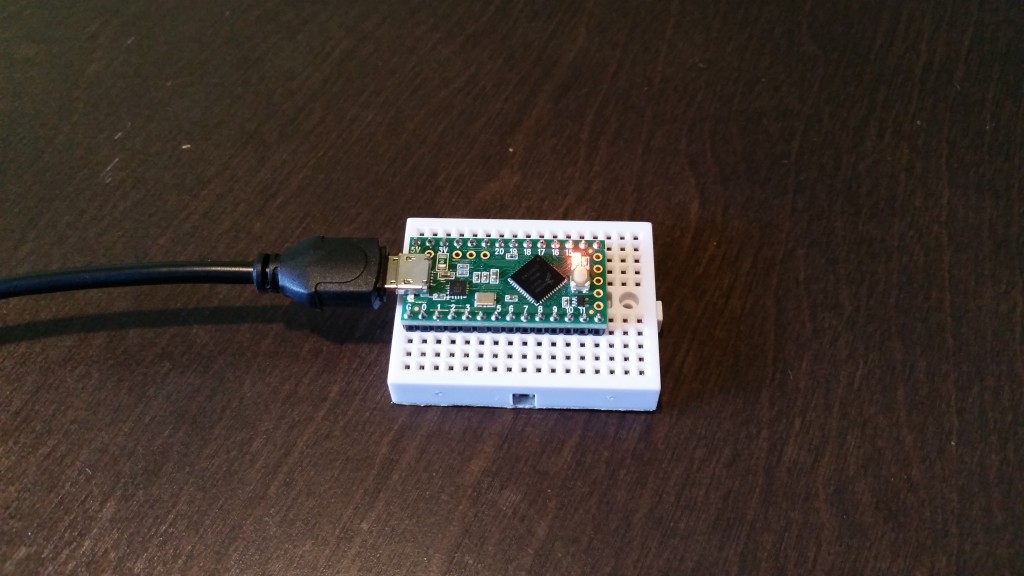As a follow-on to my PWM experiments, I wanted to create a custom interrupt service routine (ISR) in the Teensy LC. This would be similar to using the ISR() macro in an ATmega-based Arduino. Because the ARM has different vectors (and some other weird/cool things, like configurable interrupt priority levels), I knew the normal ATmega vectors would not work. Luckily, PJRC created a set of vectors to work with the Teensy, which can be found in this code.
You don’t need any additional components for this example. We are just going to flash the on-board LED using our custom ISR. The LED will flash a few times for a second and then pause (on or off) for a second. We accomplish this by enabling and disabling the ISR every second in loop().
/**
* Teensy_LC_ISR_Test.ino
* Shawn Hymel
* May 17, 2015
*
* Manually set up an interrupt service routine to toggle an LED
* on pin 13. The interrupt routine is then disabled and enabled
* every second, meaning the LED will flash for a second and then
* be stuck on or off for a second.
*
* Setting pin 13 and toggling the LED is done with the Arduino
* functions pinMode() and digitalWrite(). This is to show how
* to create a custom ISR.
*
* NVIC + ISR vectors: https://github.com/PaulStoffregen/cores/blob/master/teensy3/kinetis.h
* Cortex-M0+ Generic User Guide: http://infocenter.arm.com/help/index.jsp?topic=/com.arm.doc.dui0662b/index.html
* My post on PJRC: https://forum.pjrc.com/threads/28572-Can-t-get-__disable_irq()-to-work-on-Teensy-LC
*/
const uint8_t LED_PIN = 13;
volatile uint8_t led = 0;
void setup() {
// Set up the LED and set it low initially
pinMode(LED_PIN, OUTPUT);
digitalWrite(LED_PIN, led);
// The order of setting the TPMx_SC, TPMx_CNT, and TPMx_MOD
// seems to matter. You must clear _SC, set _CNT to 0, set _MOD
// to the desired value, then you can set the bit fields in _SC.
// Clear TPM0_SC register (p. 572)
FTM0_SC = 0;
// Reset the TPM0_CNT counter (p. 574)
FTM0_CNT = 0;
// Set overflow value (modulo) (p.574)
FTM0_MOD = 0xFFFF;
// Set TPM0_SC register (p. 572)
// Bits | Va1ue | Description
// 8 | 0 | DMA: Disable DMA
// 7 | 1 | TOF: Clear Timer Overflow Flag
// 6 | 1 | TOIE: Enable Timer Overflow Interrupt
// 5 | 0 | CPWMS: TPM in up counting mode
// 4-3 | 01 | CMOD: Counter incrememnts every TPM clock
// 2-0 | 111 | PS: Prescale = 128
FTM0_SC = 0b011001111;
// Nested Vector Interrupt Controller (NVIC) (p. 57)
// Also: Chapter 4.2 of the Generic User Guide
// Our FTM0 interrupt number is 17 (as per kinetis.h). We can
// use that to set up our interrupt vector and priority.
// Set the urgency of the interrupt. Lower numbers mean higher
// urgency (they will happen first). Acceptable values are
// 0, 64, 128, and 192. Default is 128. We set the priority
// (2nd byte) in the register for the FTM0 interrupt (&E000_E410)
// to 64.
NVIC_SET_PRIORITY(IRQ_FTM0, 64);
// Enable the interrupt vector. In this case, we want to execute
// the ISR (named "ftm0_isr()" for Teensy) every time TPM0
// overflows. We set bit 17 of &E000_E100.
NVIC_ENABLE_IRQ(IRQ_FTM0);
// Same as: NVIC_ISER0 |= (1 << 17);
}
void loop() {
// Disable our interrupt routine on and off each second
NVIC_DISABLE_IRQ(IRQ_FTM0);
delay(1000);
NVIC_ENABLE_IRQ(IRQ_FTM0);
delay(1000);
}
// "ftm0_isr" is an interrupt vector defined for the Teensy
void ftm0_isr(void) {
// First, we need to clear the timer flag so that the interrupt
// will happen again. We can take care of the rest of the
// interrupt after that.
// Write a 1 to the TOF bit to clear the timer overflow flag
FTM0_SC |= (1 << 7);
// Our interrupt routine: Toggle the LED
led = ~led;
digitalWrite(LED_PIN, led);
}


I have tested your code, and it works well. I have modified it to blink 5 led’s at different rates (1 using delay and 4 using counters inside the interruption) >> https://github.com/clovisf/Interruptions-Teensy-LC
Sorry I didn’t see this until now! Gmail started marking my WordPress notifications as spam for some reason.
Glad to hear that it worked for you!